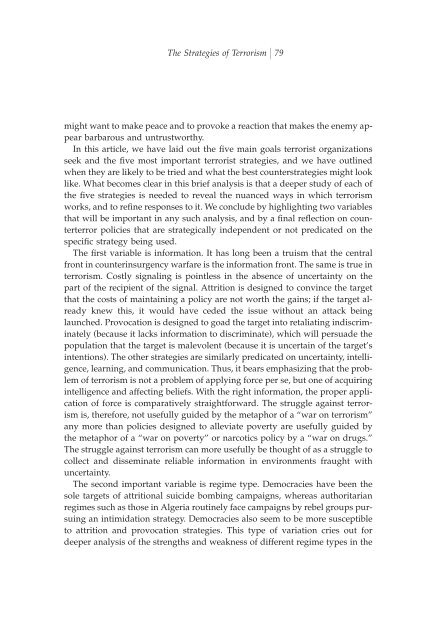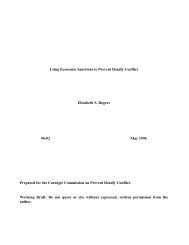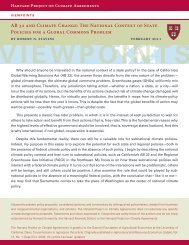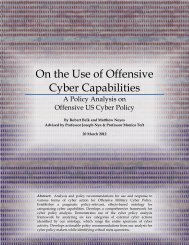The Strategies of Terrorism - MIT Press Journals
The Strategies of Terrorism - MIT Press Journals
The Strategies of Terrorism - MIT Press Journals
You also want an ePaper? Increase the reach of your titles
YUMPU automatically turns print PDFs into web optimized ePapers that Google loves.
<strong>The</strong> <strong>Strategies</strong> <strong>of</strong> <strong>Terrorism</strong> 79might want to make peace and to provoke a reaction that makes the enemy appearbarbarous and untrustworthy.In this article, we have laid out the ªve main goals terrorist organizationsseek and the ªve most important terrorist strategies, and we have outlinedwhen they are likely to be tried and what the best counterstrategies might looklike. What becomes clear in this brief analysis is that a deeper study <strong>of</strong> each <strong>of</strong>the ªve strategies is needed to reveal the nuanced ways in which terrorismworks, and to reªne responses to it. We conclude by highlighting two variablesthat will be important in any such analysis, and by a ªnal reºection on counterterrorpolicies that are strategically independent or not predicated on thespeciªc strategy being used.<strong>The</strong> ªrst variable is information. It has long been a truism that the centralfront in counterinsurgency warfare is the information front. <strong>The</strong> same is true interrorism. Costly signaling is pointless in the absence <strong>of</strong> uncertainty on thepart <strong>of</strong> the recipient <strong>of</strong> the signal. Attrition is designed to convince the targetthat the costs <strong>of</strong> maintaining a policy are not worth the gains; if the target alreadyknew this, it would have ceded the issue without an attack beinglaunched. Provocation is designed to goad the target into retaliating indiscriminately(because it lacks information to discriminate), which will persuade thepopulation that the target is malevolent (because it is uncertain <strong>of</strong> the target’sintentions). <strong>The</strong> other strategies are similarly predicated on uncertainty, intelligence,learning, and communication. Thus, it bears emphasizing that the problem<strong>of</strong> terrorism is not a problem <strong>of</strong> applying force per se, but one <strong>of</strong> acquiringintelligence and affecting beliefs. With the right information, the proper application<strong>of</strong> force is comparatively straightforward. <strong>The</strong> struggle against terrorismis, therefore, not usefully guided by the metaphor <strong>of</strong> a “war on terrorism”any more than policies designed to alleviate poverty are usefully guided bythe metaphor <strong>of</strong> a “war on poverty” or narcotics policy by a “war on drugs.”<strong>The</strong> struggle against terrorism can more usefully be thought <strong>of</strong> as a struggle tocollect and disseminate reliable information in environments fraught withuncertainty.<strong>The</strong> second important variable is regime type. Democracies have been thesole targets <strong>of</strong> attritional suicide bombing campaigns, whereas authoritarianregimes such as those in Algeria routinely face campaigns by rebel groups pursuingan intimidation strategy. Democracies also seem to be more susceptibleto attrition and provocation strategies. This type <strong>of</strong> variation cries out fordeeper analysis <strong>of</strong> the strengths and weakness <strong>of</strong> different regime types in the














